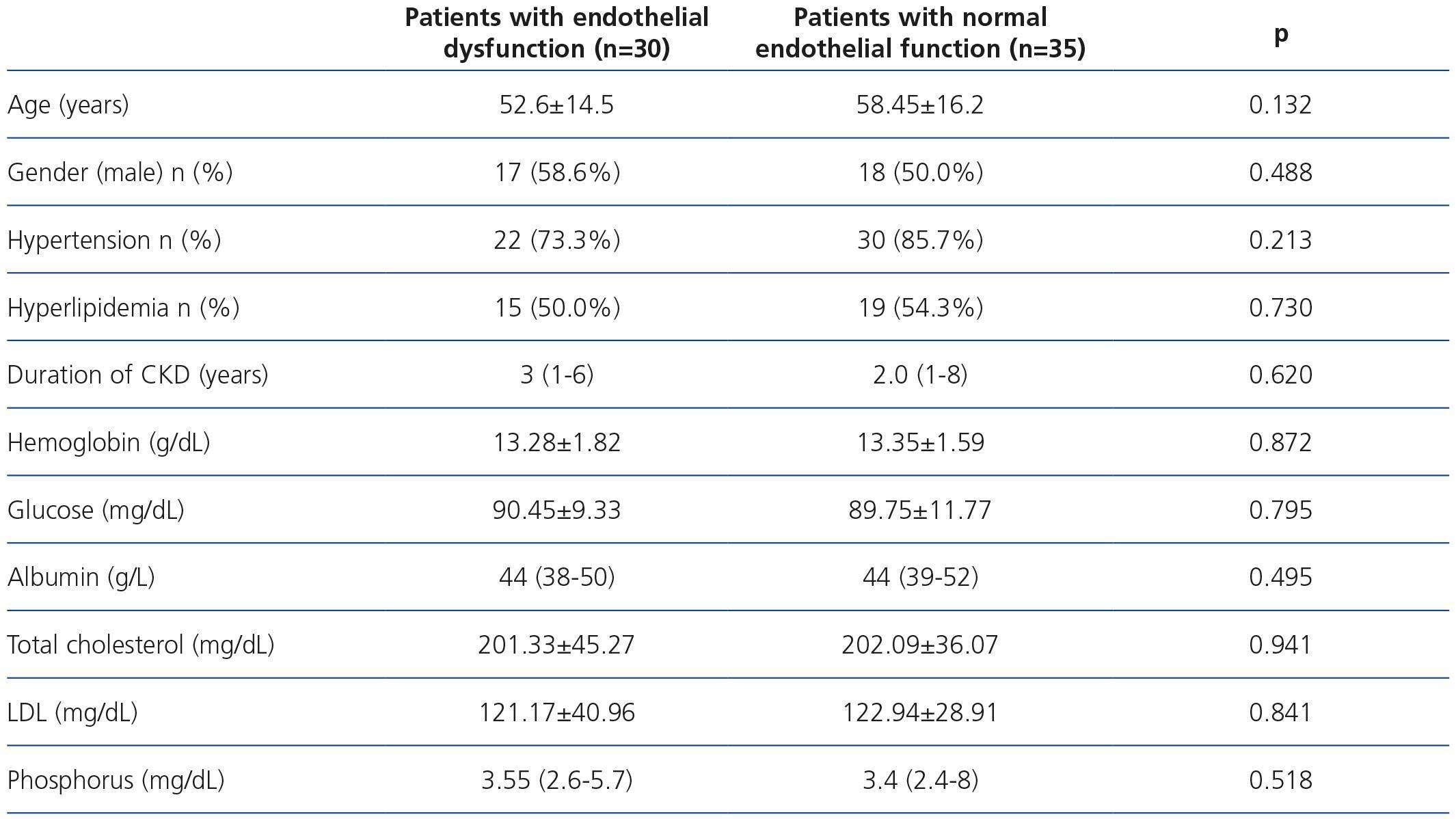Este estudio se llevó a cabo con el objetivo de investigar el papel de la catepsina D, un mediador inflamatorio y aterosclerótico de la disfunción endotelial en la enfermedad renal crónica. En él, se incluyó a 65 pacientes con enfermedad renal crónica en los estadios 2-4 (35 mujeres y 30 hombres con una media de edad de 55,8 ± 15,6 años). Se calcularon los niveles séricos de creatinina y catepsina D así como la tasa de filtrado glomerular (TFG) y se midió el porcentaje de dilatación mediada por flujo (DMF) de la arteria braquial mediante angiografía y ecografía doppler bidimensional en color y en escala de grises. Se consideró que una DMF de ≤6% era indicativa de disfunción endotelial. La TFG media, la mediana de los niveles de creatinina y la mediana de los niveles de catepsina D fueron, respectivamente, 40,2 ± 11,2 mL/min/1,73 m2; 1,7 mg/dL; y 819,75 ng/mL. La disfunción endotelial afectaba a 30 de los 65 pacientes (46,2%). Entre los grupos con y sin disfunción endotelial, se observó una diferencia significativa en los niveles de catepsina D (p = 0,001) y creatinina (p = 0,03) así como correlaciones significativas y negativas entre el porcentaje de DMF de la arteria braquial y los niveles de catepsina D (r = −0,359, p = 0,003) y creatinina (r = −0,304, p = 0,014). La catepsina D, que se asocia a la aterosclerosis, tiene un papel importante en el proceso de disfunción endotelial. Es fundamental que se realicen otros estudios que puedan determinar la función exacta de la catepsina D en la disfunción endotelial y su valor como herramienta de diagnóstico temprano y como diana del tratamiento de enfermedades cardiovasculares en pacientes con enfermedad renal crónica.
We aimed to investigate the role of cathepsin D, an inflammatory and atherosclerotic mediator, in endothelial dysfunction in chronic kidney disease. The study included 65 patients with stage 2–4 chronic kidney disease (35 females, 30 males; mean age, 55.8±15.6 years). Serum creatinine and cathepsin D levels and glomerular filtration rates (GFRs) were determined, and brachial flow-mediated dilation (FMD) percentage was measured by two-dimensional gray scale and color flow Doppler and vascular imaging. FMD ≤6% was considered to indicate endothelial dysfunction. Mean GFR, median creatinine levels, and median cathepsin D levels were 40.2±11.2mL/min/1.73m2, 1.7mg/dL, and 819.75ng/mL, respectively. Endothelial dysfunction was present in 30 of the 65 patients (46.2%). There was a significant difference between groups with and without endothelial dysfunction in terms of cathepsin D (p=0.001) and creatinine (p=0.03) levels, and negative and significant correlations were found between brachial artery FMD% and cathepsin D (r=−0.359, p=0.003) and creatinine (r=−0.304, p=0.014) levels. Cathepsin D, which is known to be associated with atherosclerosis, may play a role in the process of endothelial dysfunction. Further studies are essential to determine the exact function of cathepsin D in endothelial dysfunction in chronic kidney disease and to determine its value as a tool for early diagnosis and target for treatment of cardiovascular diseases in patients with chronic kidney disease.








